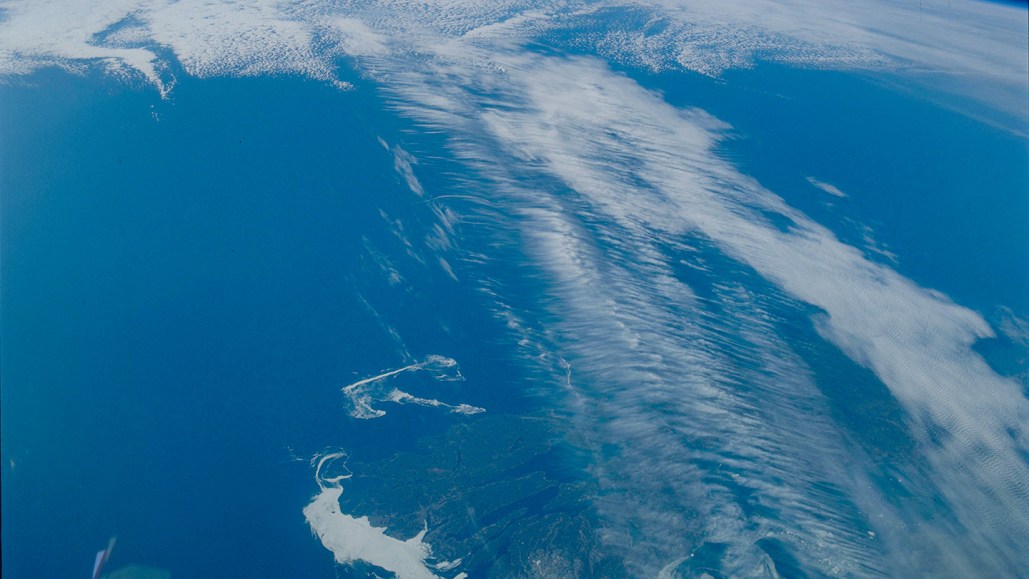"How Earth’s Jet Stream Contributes to Cloud Formation"

Scientists have sussed out a new source for the seeds of clouds. When the stratospheric layer of Earth’s atmosphere dips a toe into the underlying troposphere, the resulting chemical mixture becomes a fertile environment where tiny new particles, including the microscopic aerosols around which clouds begin to coalesce, can form.
Data collected by four flights of NASA aircraft in different regions of the northern hemisphere in 2016 and 2017 confirmed that this mechanism, called stratospheric air intrusion, is not only a source of new particles but also may be the most productive place for these particles on Earth, Jiaoshi Zhang, an aerosol scientist at Washington University in St. Louis, and colleagues report in the July 12 Science.
Previously, scientists have thought that most new particle formation happens in regions of the atmosphere where clouds float upward into the upper troposphere and dissipate. As the clouds there rain out, any existing particles are removed with the rainwater. What’s left behind in these “cloud outflow” regions is a blank slate, basically particle free, so that gaseous molecules have nothing existing to glom onto. Instead, they make new particles.
But the airborne observations suggest that stratospheric air intrusions are even more productive when it comes to particle formation. Turbulence in the atmosphere caused by the jet stream, a fast-moving current of air, can cause fingers of stratospheric air to punch down and curl into the troposphere below.
The two atmospheric layers have very different chemical makeups, and where those air masses mix, they generate very productive particle factories, says study coauthor Jian Wang, an aerosol scientist also at Washington University in St. Louis. The stratosphere is cold and ozone-rich, while the troposphere is warmer, moister and contains a variety of molecules such as sulfur dioxide. Catalyzed by sunlight and water, the chemical reaction of these air masses may generate a variety of tiny particles, including cloud-seeding sulfate.
Exactly which and how many particles are being formed by these stratospheric air intrusions is a subject for future work, Wang says. “We don’t really understand the mechanisms in detail. We know from the data that … you need sunshine, high ozone and moisture” to produce highly reactive molecules known as OH radicals (SN: 6/4/09). Those molecules eagerly interact with other gases in the atmosphere. So there are probably many different chemical reactions going on in these regions, producing a variety of new molecules and particles.
Waviness of the jet stream can lead to stratospheric air intrusion (illustrated below), in which the ozone (O3)-rich stratosphere dips down into the water-rich troposphere. The troposphere also contains a variety of gaseous molecules such as sulfur dioxide (SO2), emitted by fossil fuels and volcanoes. The chemical reactions between the two layers, catalyzed by sunlight and water vapor, generate the precursors of fine aerosol particles, such as sulfuric acid (H2SO4). Previous research suggested that the primary mechanism for new particle formation in the atmosphere were “cloud outflow” regions, where clouds disintegrate high in the troposphere.
Despite these uncertainties, the team’s analysis of the frequency and productiveness of stratospheric air intrusions, compared with cloud outflow events, suggests that the intrusions may be a bigger source of new particles, particularly in Earth’s midlatitude regions. And climate change is expected to intensify stratospheric circulation around Earth, which in turn could increase how often the stratosphere pokes into the troposphere in the future. That suggests this mechanism may become even more important to the formation of new particles, Wang says.
These findings highlight an important source of new particle formation that has been long overlooked but turns out to occur “ubiquitously and frequently” in the atmosphere, says Yuanlong Huang, an atmospheric aerosol chemist at the Eastern Institute for Advanced Study in Ningbo, China, who was not involved in the new study. “It’s a mechanism not yet included in current Earth system models.”
And such a large, previously unsuspected source of new particles, in turn, could mean that the generation of these particles plays a bigger role in how incoming solar radiation is distributed on Earth — including how much reaches the planet’s surface, compared with how much is absorbed by aerosols and clouds high in the atmosphere — than scientists once thought.




